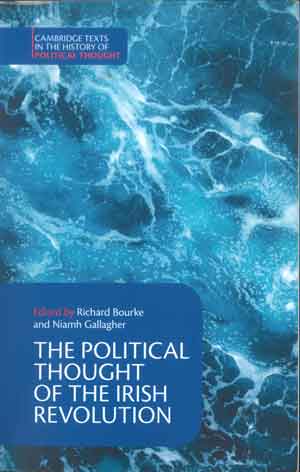RICHARD BOURKE and NIAMH GALLAGHER (eds)
Cambridge University Press
£22.99
ISBN 9781108799133
Reviewed by Brian Hanley
Brian Hanley is Assistant Professor of Twentieth-Century Irish History at Trinity College, Dublin.
‘When we were little children Johnnie Redmond was a fool, He bade us to be happy with something called Home Rule, But we’ve learned a thing or two since we went to school And we’ll crown de Valera King of Ireland.’

The above lyrics of a popular street song c. 1918 appeared in Terry Moylan’s The indignant muse: poetry and songs of the Irish revolution, published in 2016. Moylan’s book provided a glimpse into the mind-sets of at least some of the people who took part in the Irish revolution. As the song suggests, there were multiple understandings of what constituted republicanism. The same applied to visions of Home Rule. When in 1912 crowds in O’Connell Street cheered John Dillon’s promise that ‘Cromwell’s work [was] nearly undone’, did they really imagine that he was talking about limited self-government?
These questions sprang to mind when reading Richard Bourke and Niamh Gallagher’s anthology of some of the writing produced during a period of intense intellectual ferment in Ireland. Like Declan Kiberd and P.J. Mathew’s Handbook of the Irish Revival (2015), the editors include a variety of contemporary texts: unionist, nationalist, feminist, socialist and separatist. Some of the choices (the 1916 Proclamation, the Ulster Covenant) are obvious but necessary; others are less well known but still illuminating. Yet I could not help feeling disappointed by this collection. There is an over-concentration on the pre-1916 period and on a few major thinkers at the expense of popular periodicals. The IRA, for example, published a weekly paper, An t-Óglách, which contained not only practical instructions for Volunteers but also articles detailing the revolutionary wave in Europe and news of anti-colonial revolts, such as the Malabar rebellion in India. Another weekly, New Ireland, edited by P.J. Little, was able, despite censorship, to publish writers like P.S. O’Hegarty, Peadar O’Donnell and Frank Gallagher. In it we find debates about the Belfast Boycott, discussions about British labour and critiques of Irish America, as well as accounts of the struggles of Ireland’s ‘brothers in pain’ in India and Egypt. References to India and Egypt abounded in separatist periodicals but there were also discordant notes. Irish radicals appear to have accepted without question German propaganda about the ‘Black Horror on the Rhine’ (a racist panic about France’s deployment of colonial soldiers in Germany). Aodh de Blácam, a regular contributor to New Ireland, was, as Seán Donnelly has recently asserted, one of the most significant separatist thinkers. It was de Blácam who noted in What Sinn Féin stands for (1921) that, while ‘Catholic communities are generally hostile to socialism’, nowhere ‘was the Bolshevik revolution more sympathetically saluted’ than in Ireland. This phenomenon was well illustrated by Thomas Johnson’s article ‘If the Bolsheviks came to Ireland’, published in the Voice of Labour in February 1918. There is, however, no room for either de Blácam or Johnson in this collection, nor indeed for the widely read Voice of Labour.
There are several articles by James Connolly, but his post-1916 popularity might have been better illustrated by Gerald O’Connor’s best-selling James Connolly: a study of his work and worth (1917). There is little indication of the fact that after 1916 the labour movement was far more influential than when Connolly was alive. Indeed, many of Eamon de Valera’s speeches, especially to American audiences, often touched on labour and social reform, as well as religion and race. In September 1919 the Sinn Féin leader told a New York audience that while ‘the leisured classes were sometimes seduced from their national allegiance by a seat at the conqueror’s table … Irish labor ever stood true to its convictions. … When Irish patriots despaired of winning to their side—the side of sacrifice—the people of property, they could always count on that very respectable class, the people of no property.’ It is surely significant that this speech was reprinted in the labour press in Ireland, but de Valera does not feature in this collection at all.
Most scholars agree that the post-1916 perception of the Rising’s leadership’s religious piety owed much to its framing by the Catholic Bulletin. That publication, edited by J.J. O’Kelly (a Sinn Féin TD after 1918), was also a sounding-board for a range of republican voices. Questions as to separatist attitudes towards censorship and religious tolerance, surely germane to the culture of the state that emerged after independence, could be traced here. And, aside from newspapers and pamphlets, where else were political ideas expressed? Sometimes from platforms at rallies and meetings, in election leaflets, on posters or in verse. Excerpts from some of the speeches made by Sinn Féin activists during the 1918 election, which invariably referenced Woodrow Wilson and self-determination, would have helped us to understand how important this was in appealing to a new electorate. The revolutionary Dáil published three important documents in January 1919: a Declaration of Independence, a Message to the Free Nations of the World and the Democratic Programme. Yet there is no reference in the collection to them, nor to later publications like The constructive work of Dáil Éireann. The book’s editors have been rightly critical of a tendency to view the Irish revolution as almost devoid of political ideas, but their selection is frustratingly narrow. If this review seems over-critical it is because this was a missed opportunity to examine the diversity of revolutionary thought.
